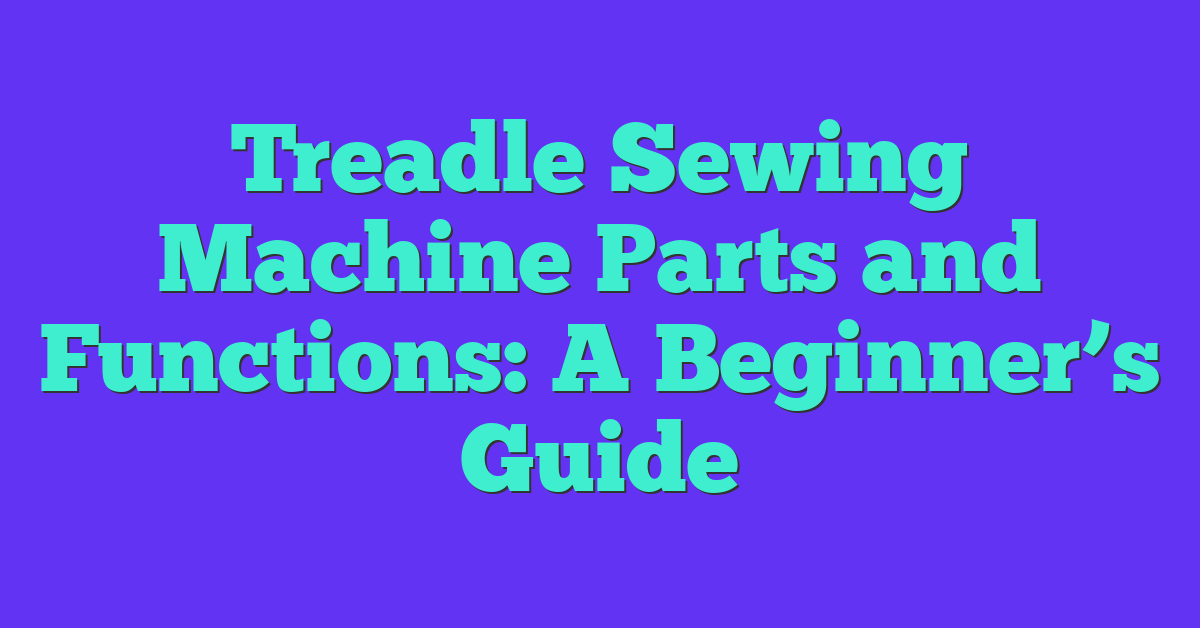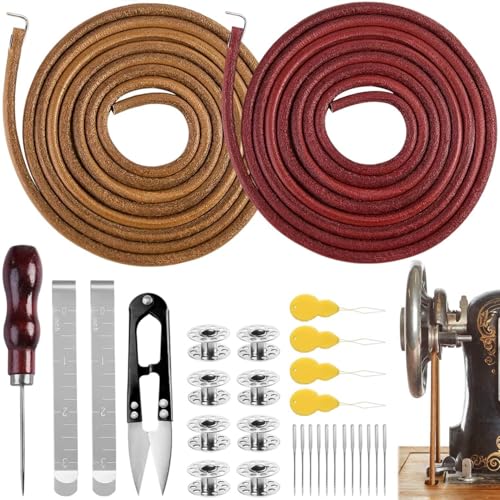As a sewing enthusiast, I have always been fascinated by the treadle sewing machine. These machines, which were once the primary sewing machine in many households, have a unique mechanism that allows them to operate without electricity. However, understanding the parts and functions of a treadle sewing machine can be overwhelming for beginners. In this article, I will break down the main components of a treadle sewing machine and their functions, so you can use your machine with confidence.
The treadle sewing machine is a vintage sewing machine that is still popular among sewing enthusiasts. It is operated by a foot pedal, which drives a belt that turns the machine’s flywheel. This, in turn, powers the needle and the bobbin, creating a stitch. The treadle sewing machine is a great option for those who want to sew without electricity, and it is also a beautiful piece of history that can be passed down from generation to generation.
Key Takeaways
- Treadle sewing machines are vintage machines that are still popular among sewing enthusiasts.
- The machines are operated by a foot pedal and a belt that turns the flywheel, powering the needle and the bobbin.
- Understanding the parts and functions of a treadle sewing machine is essential for using it with confidence.
Understanding the Treadle Sewing Machine
As someone who loves sewing, I find that understanding the parts and functions of a treadle sewing machine is essential. A treadle sewing machine is a mechanical machine that is operated by pushing back and forth a foot pedal manually. It is a reminder of America’s industrial knowledge and might and is still used by many people today.
The mechanism of a treadle sewing machine is quite simple. When you push the foot pedal, it rotates a flywheel, which in turn moves the main shaft. The main shaft then drives the needle and the shuttle, which forms the stitch. The design of the treadle machine is such that it is powered by your own foot, making it a great way to get some exercise while sewing.
One of the most important parts of a treadle sewing machine is the treadle itself. This is the pedal that you push back and forth with your foot to power the machine. The treadle is connected to a series of pulleys and belts that drive the machine’s mechanism.
Another crucial part of the treadle sewing machine is the shuttle. The shuttle is the part of the machine that holds the bobbin and thread and moves back and forth to create the stitch. The shuttle moves in a figure-eight pattern, which is why it is sometimes called a “boat shuttle.”
Isaac Singer was one of the pioneers of the treadle sewing machine. He designed a machine that was easy to use and maintain, making it accessible to people of all skill levels. Today, treadle sewing machines are found at antique shops, in auction houses, at garage sales, and even in junk stores. They are a testament to the ingenuity of the human mind and a reminder of a time when things were built to last.
In conclusion, understanding the parts and functions of a treadle sewing machine is essential for anyone who loves sewing. From the treadle to the shuttle, each part of the machine plays a crucial role in creating beautiful stitches. Whether you are a beginner or an experienced sewer, a treadle sewing machine is a great way to connect with the past and create something beautiful.
Main Parts of a Treadle Sewing Machine
As a sewing enthusiast, I have always been fascinated by the intricate workings of a treadle sewing machine. Understanding the different parts and their functions is crucial to using the machine effectively. In this section, I will discuss the main parts of a treadle sewing machine, divided into two sub-sections: upper parts and lower parts.
Upper Parts
The upper parts of a treadle sewing machine include the head, arm, and bed. The head houses the hand wheel, needle, needle clamp, and needle bar. The hand wheel is used to manually move the needle up and down. The needle clamp holds the needle in place, and the needle bar moves the needle up and down through the fabric.
The arm of the machine holds the thread guide, thread cutter, and bobbin winder thread guide. The thread guide helps to guide the thread through the machine, while the thread cutter is used to cut the thread after sewing. The bobbin winder thread guide helps to guide the thread onto the bobbin when winding.
The bed of the machine is where the fabric is placed for sewing. It also houses the thread take-up lever, tension disc, spool pin, and tension discs. The thread take-up lever moves the thread up and down, while the tension discs control the tension of the thread. The spool pin holds the spool of thread, and the tension discs keep the thread taut.
Lower Parts
The lower parts of a treadle sewing machine include the belt guide, band wheel, legs, belt shifter, treadle motion, belts, and foot pedal. The belt guide helps to guide the belt around the band wheel, which is responsible for powering the machine. The legs provide support for the machine, while the belt shifter is used to engage or disengage the belt.
The treadle motion is what powers the machine, and it is controlled by the foot pedal. The belts connect the treadle to the band wheel, and the bobbin winder stopper is used to stop the machine from moving while winding the bobbin.
Other important parts of a treadle sewing machine include the feed dog, feed dogs, bobbin, bobbin case, bobbin cover, stitch regulator, stitch width dial, stitch length dial, reverse stitch lever, and power switch. The feed dog is responsible for moving the fabric through the machine, while the bobbin and bobbin case hold the thread for the bottom stitch. The stitch regulator, stitch width dial, and stitch length dial control the type and size of the stitch, and the reverse stitch lever is used to sew in reverse. The power switch turns the machine on and off.
In summary, understanding the main parts of a treadle sewing machine is crucial to using it effectively. From the upper parts, such as the head, arm, and bed, to the lower parts, such as the belt guide, band wheel, and foot pedal, each part plays an important role in the machine’s overall function.
Features and Functions
As a proud owner of a treadle sewing machine, I have come to appreciate the many features and functions that make it such a joy to use. Here are some of the key features and functions that you can expect to find on most treadle sewing machines:

Stitch Length
One of the most important features of any sewing machine is the ability to adjust the stitch length. On a treadle sewing machine, this is typically done by adjusting the position of the stitch regulator. By moving the regulator closer to the needle, you can create shorter stitches, while moving it further away will result in longer stitches. This feature is essential for creating different types of stitches, such as the straight stitch or the zigzag stitch.
Presser Foot
The presser foot is another essential component of a treadle sewing machine. This part of the machine helps to hold the fabric in place while you sew, ensuring that your stitches are even and consistent. The pressure of the foot can be adjusted depending on the thickness of the fabric you are working with, allowing you to sew through multiple layers of material with ease.
Straight Stitch
The straight stitch is the most basic stitch that can be created on a treadle sewing machine. This stitch is created by moving the fabric back and forth under the needle, creating a series of straight lines. It is the perfect stitch for creating seams and hems, and can be used on a wide variety of fabrics.
Reverse Lever
A reverse lever is a small lever located on the side of the machine that allows you to sew in reverse. This feature is particularly useful when you need to reinforce a seam or create a secure starting or stopping point.
Pressure Foot Lever
« Singer Quantum Stylist 9960 Problems: Troubleshooting Tips
Singer 1234 Sewing Machine Review: A Comprehensive Guide »
The pressure foot lever is used to control the pressure applied by the presser foot. By adjusting the pressure, you can ensure that your stitches are even and consistent, regardless of the thickness of the fabric you are working with.
Overall, the features and functions of a treadle sewing machine are designed to make sewing a joy. Whether you are a beginner or an experienced seamstress, a treadle sewing machine is a reliable and versatile tool that can help you create beautiful, high-quality garments and accessories.
Maintenance and Care
As a proud owner of a treadle sewing machine, I know that taking care of it is crucial to ensure its longevity and smooth operation. Here are some tips on how to maintain and care for your treadle sewing machine:
Oil Your Machine Regularly
One of the most important things you can do to keep your treadle sewing machine running smoothly is to oil it regularly. I recommend using a high-quality sewing machine oil and applying it to all moving parts of the machine. Be sure to wipe off any excess oil to prevent it from getting on your fabric.
Keep It Quiet
If your treadle sewing machine is making a lot of noise, it may be a sign that it needs some attention. Check to make sure that all screws and bolts are tightened and that there are no loose or worn parts. If the noise persists, you may need to take your machine to a professional for further inspection.
Maintain Treadle Motion
The treadle motion is what drives the sewing machine, so it’s important to keep it in good condition. Make sure that the treadle mechanism is moving freely and that there is no resistance or tightness. If you notice any issues, try cleaning the mechanism or adjusting the tension.
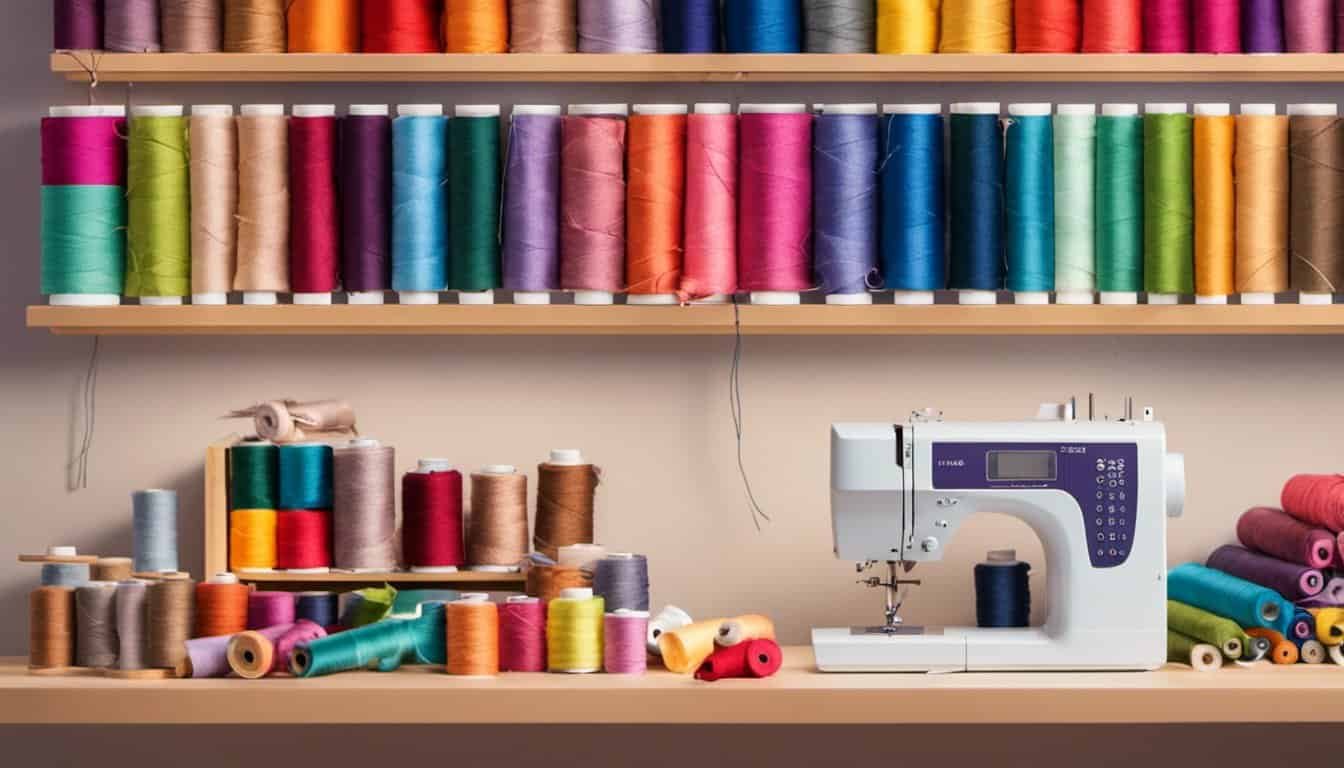
Keep a Steady Rhythm
The rhythm of your treadle sewing machine is important for creating even stitches. If you find that your machine is skipping stitches or creating uneven stitches, it may be a sign that your rhythm is off. Try practicing your footwork and adjusting the speed of your treadling until you find a steady rhythm.
Check the Tightness
It’s important to check the tightness of your treadle sewing machine regularly. Make sure that all screws and bolts are tightened and that there is no play in the mechanism. If you notice any looseness or play, try tightening the screws or adjusting the tension.
Use the Brake
Most treadle sewing machines come with a brake that can be used to stop the machine quickly. It’s important to use the brake when necessary to prevent damage to the machine or injury to yourself. Make sure that the brake is working properly and that you know how to use it before you start sewing.
By following these tips, you can keep your treadle sewing machine in great condition and enjoy many years of happy sewing.
Treadle Sewing Machines in Today’s Age
As a modern sewist, I often find myself drawn to the vintage charm of treadle sewing machines. These machines, which were once a staple in homes across the country, have now become a sought-after item for those looking to add a touch of history to their sewing space.
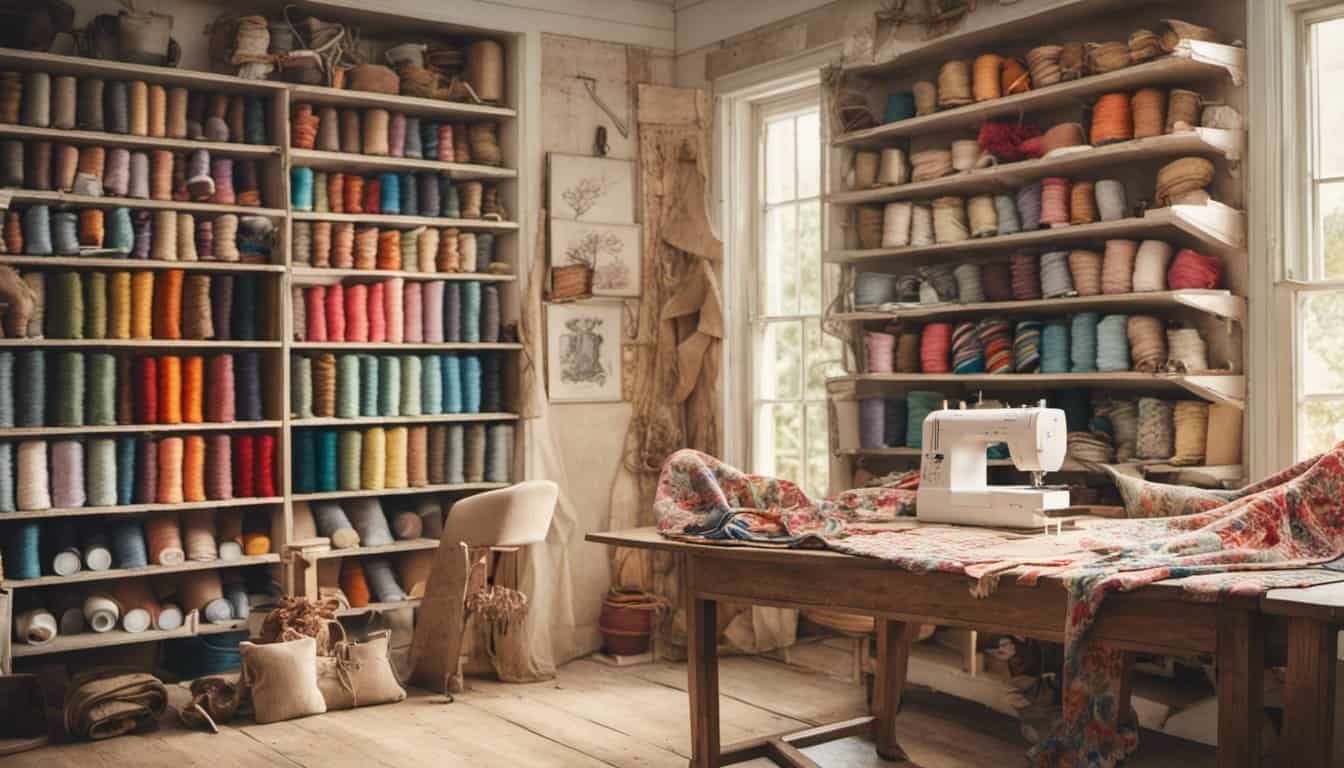
While it may seem like these machines are a thing of the past, they are still readily available if you know where to look. One great place to start your search is at garage sales and antique shops. You never know what hidden treasures you might find! Another option is to check out online marketplaces like Etsy, where you can find a wide variety of vintage sewing machines.
Not only are treadle sewing machines a unique addition to your sewing space, but they also offer a sustainable option for those looking to reduce their environmental impact. By using a treadle machine, you are able to sew without relying on electricity, making it a great option for those looking to live a more eco-friendly lifestyle.
When it comes to using a treadle sewing machine, there are a few things to keep in mind. First, it’s important to familiarize yourself with the different parts and functions of the machine. This includes the foot pedal, which is used to power the machine, as well as the various knobs and levers that control the stitching.
Overall, treadle sewing machines are a great option for those looking to add a touch of vintage charm to their sewing space while also embracing a more sustainable lifestyle. So why not give it a try and see what you can create on one of these beautiful machines?
Using Treadle Sewing Machines for Different Materials
When it comes to sewing, different materials require different techniques and tools. The same goes for treadle sewing machines. Here are some tips on how to use a treadle sewing machine for different materials:
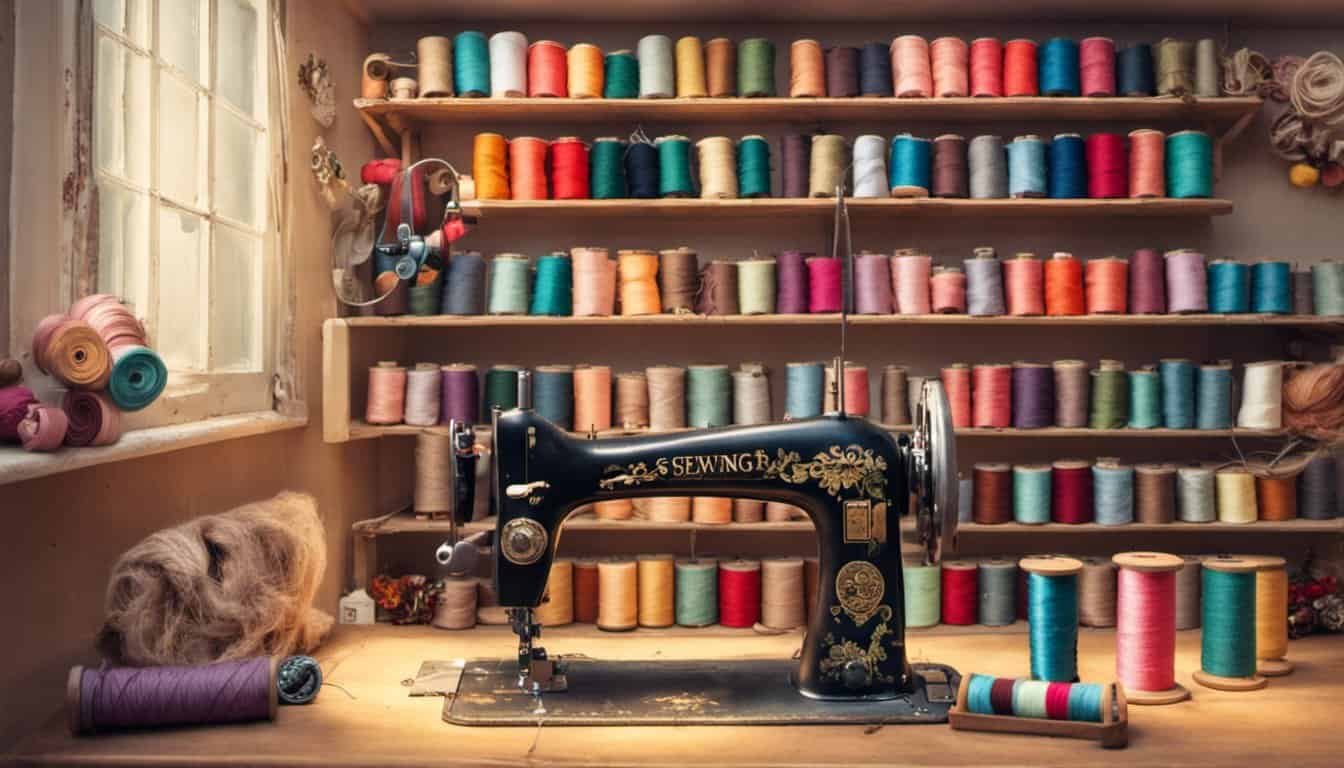
Leather
Leather is a tough material that requires a sturdy sewing machine. A treadle sewing machine is perfect for sewing leather because it has a strong motor and can handle the thickness of the material. When sewing leather, it is important to use a heavy-duty needle and to adjust the tension of the machine accordingly. It is also recommended to use a walking foot to prevent the leather from slipping.
Staples
Staples are another material that can be sewn using a treadle sewing machine. Staples are thin and delicate, so it is important to use a fine needle and adjust the tension of the machine accordingly. When sewing staples, it is also important to use a work surface that is smooth and flat to prevent the staples from getting caught.
Groove
Sewing in a groove can be challenging, but a treadle sewing machine can make it easier. When sewing in a groove, it is important to use a foot that is designed for the job. A groove foot has a small groove in the center that allows the needle to move smoothly through the material. It is also important to adjust the tension of the machine accordingly.
Work Surface
The work surface is an important part of using a treadle sewing machine. It should be smooth and flat to prevent the material from getting caught or wrinkled. It should also be sturdy enough to support the weight of the machine and the material being sewn. A good work surface can make all the difference when using a treadle sewing machine.
In conclusion, a treadle sewing machine can be used to sew a variety of materials, including leather, staples, and grooves. It is important to use the right tools and techniques for each material, and to have a smooth and sturdy work surface. With the right setup, a treadle sewing machine can be a versatile and reliable tool for any sewing project.

How to Find and Purchase a Treadle Sewing Machine
As a lover of all things vintage, I have found that searching for a treadle sewing machine can be a fun and exciting adventure. Here are some tips on where to find and purchase a treadle sewing machine.
Garage Sales and Antique Shops
One of the best places to find a treadle sewing machine is at garage sales or antique shops. These places often have hidden gems that are waiting to be discovered. When searching for a treadle sewing machine, be sure to keep an eye out for any signs of rust or damage. It is also a good idea to test the machine to ensure that it is in working condition.
Etsy
Etsy is a great online marketplace where you can find a variety of vintage and antique items, including treadle sewing machines. When searching on Etsy, be sure to read the seller’s description carefully and look at all of the photos provided. It is also a good idea to check the seller’s reviews to ensure that they have a good reputation.
Join Lists and News Groups
Joining lists and news groups is a great way to connect with other vintage enthusiasts who may have a treadle sewing machine for sale. These groups often have members who are knowledgeable about treadle sewing machines and can provide helpful advice and information.
Other Tips
When purchasing a treadle sewing machine, be sure to ask the seller about the machine’s history and any maintenance that has been done. It is also a good idea to research the brand and model of the machine to ensure that it is a quality machine that will meet your needs.

In conclusion, finding and purchasing a treadle sewing machine can be a fun and rewarding experience. By keeping these tips in mind, you can find a quality machine that will provide you with years of sewing pleasure.
Frequently Asked Questions
What are the different parts of a treadle sewing machine?
A treadle sewing machine consists of several parts, including the treadle, the belt, the flywheel, the needle, the shuttle, the bobbin, and the feed dogs. Each of these parts plays a crucial role in the functioning of the machine.
How do the different parts of a treadle sewing machine work together?
The treadle is used to power the machine, while the belt connects the treadle to the flywheel, which turns the needle. The needle then passes through the fabric, and the shuttle and bobbin work together to create the stitch. The feed dogs help to move the fabric along, ensuring a smooth and even stitch.
What are some common issues with treadle sewing machines and how can they be fixed?
Some common issues with treadle sewing machines include broken or slipping belts, dull needles, and tension problems. These issues can often be fixed by replacing the broken or worn-out parts, cleaning and oiling the machine, and adjusting the tension as needed.
What are some tips for maintaining a treadle sewing machine?
To keep your treadle sewing machine in good working order, it is important to clean and oil it regularly, use high-quality replacement parts when needed, and store it in a dry and dust-free environment. It is also important to use the correct needle and thread for the type of fabric you are working with.

How can I identify the model of my old treadle sewing machine?
To identify the model of your old treadle sewing machine, you can look for identifying marks or serial numbers on the machine itself, or consult a reference book or online resource for vintage sewing machines. You can also reach out to a local antique dealer or sewing machine repair specialist for assistance.
What are some resources for finding replacement parts for an old treadle sewing machine?
There are several resources available for finding replacement parts for an old treadle sewing machine, including online retailers, vintage sewing machine dealers, and sewing machine repair specialists. It is important to ensure that any replacement parts you purchase are compatible with your specific make and model of treadle sewing machine.


